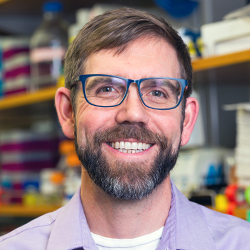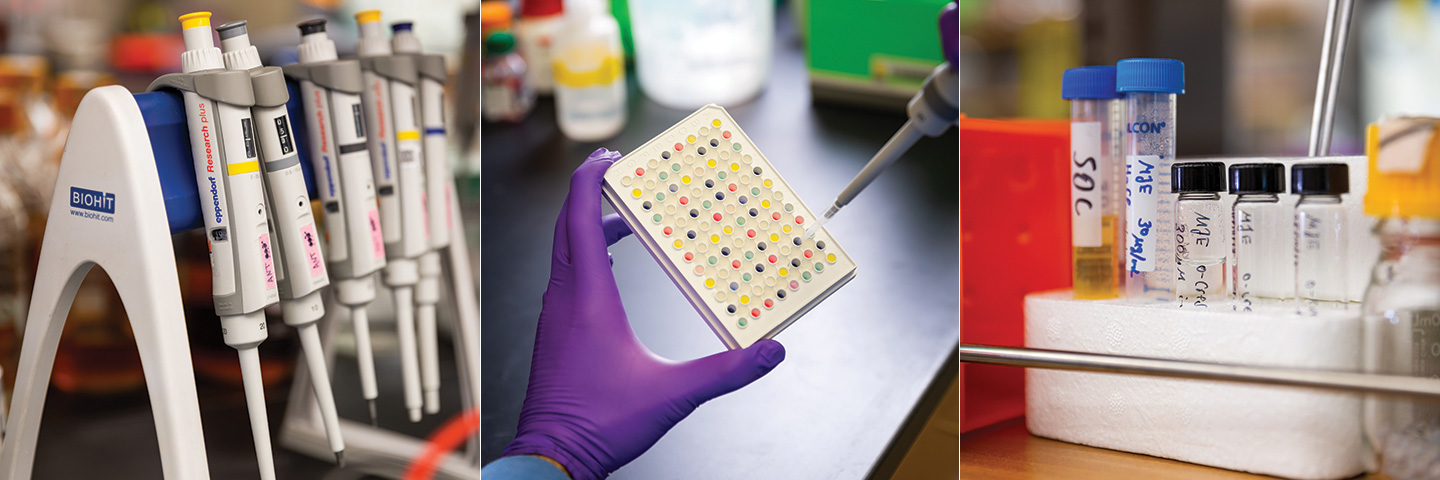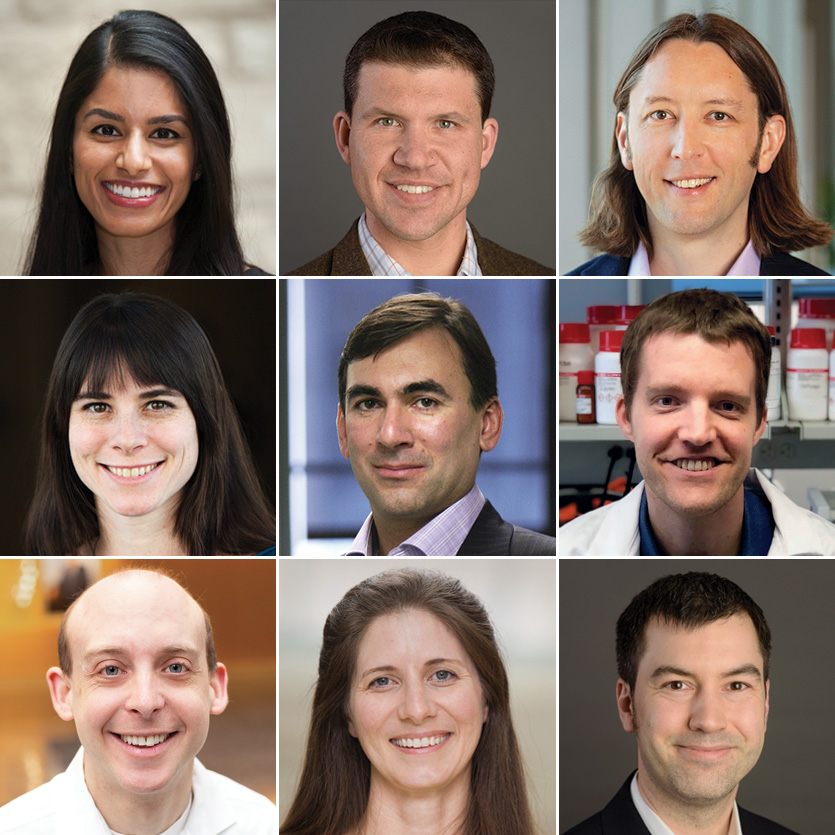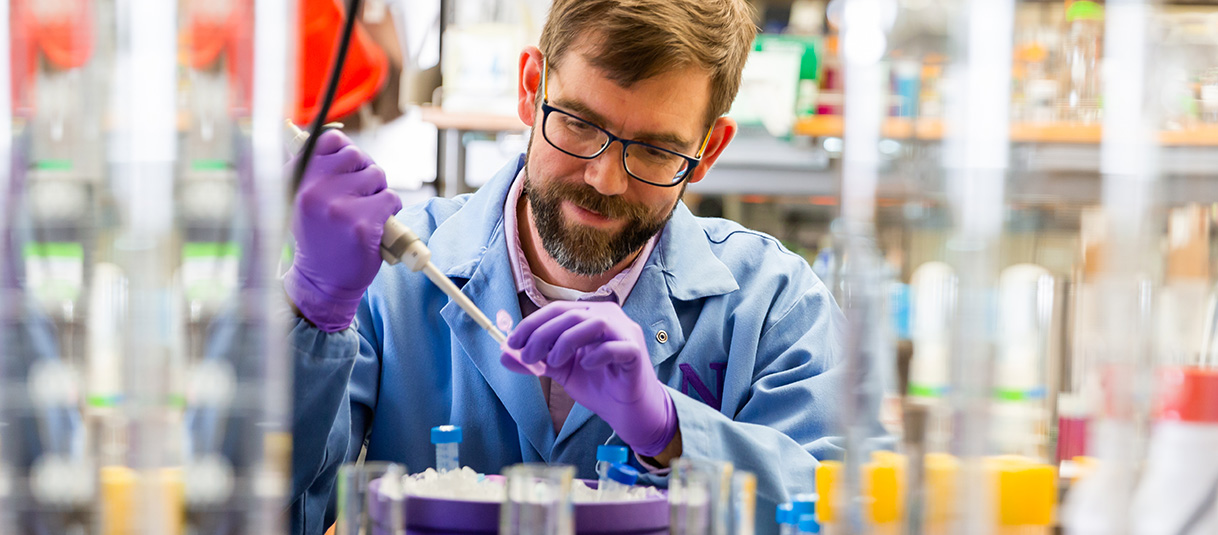BY ALEX GERAGE // view article PDF
PHOTOGRAPHY BY MATTHEW ALLEN
If you ask Northwestern Engineering’s Michael Jewett, he’ll tell you the potential of cell-free gene expression has always made sense. Rip off the wall of the cell, collect its insides, and teach the cell catalyst to produce new kinds of molecules and biological processes without the evolutionary constraints imposed by using intact living cells.

But less than 20 years ago, acknowledges Jewett, Walter P. Murphy Professor of Chemical and Biological Engineering and Charles Deering McCormick Professor of Teaching Excellence at the McCormick School of Engineering, this burgeoning field within synthetic biology still had much to prove.
“People thought we were crazy,” he says. “When I was a graduate student, the idea of making a protein therapeutic in cell-free systems was so obscure. At best, it wasn’t going to be cost effective enough to be useful, or the system wasn’t going to produce enough protein to do anything worthwhile.”
Now, cell-free synthetic biology holds great promise. The field has evolved from a specialized research tool to the backbone of a variety of applications ready to tackle some of society’s greatest challenges, from COVID-19 to cancer to climate change.
“The time for cell-free systems is here. It’s now,” he says.
Cell-free synthetic biology is growing in importance thanks to the leadership of Northwestern’s Center for Synthetic Biology. Launched in 2016 and directed by Jewett, the center brings together the brightest minds in the field to provide a supportive ecosystem for research and education.
“The center has grown into one of the leaders in synthetic biology in the United States, and perhaps the world,” Jewett says. “As our team has come together, we’ve thought about research themes that would not only connect our members, but also position Northwestern as having a particular strength. Cell-free systems has emerged as one of those.”
A technological renaissance
Although cell-free gene expression has been a research tool for more than 50 years, its potential has been limited by several constraints, including low and variable protein synthesis yields, short reaction durations, and small reaction scale.
In the last 20 years, however, synthetic biology researchers have gradually peeled back the curtain of cell-free gene expression’s transformative potential, uncovering insights that led to new efficiencies and applications outside of the lab—from biosensors that measure and monitor environmental contaminants in natural resources, like lead in water, to targeted therapeutics that treat diseases like cancer.
Jewett and collaborators, for example, developed a high-yielding, one-pot, cell-free protein synthesis platform derived from a genomically recoded strain of Escherichia coli. The system is not only optimized to produce the highest batch reaction expression yield of a protein to date, but the platform also can make proteins with non-canonical amino acids. That work expands the genetically encoded chemistry available to proteins and opens the door to create new types of enzymes, the foundation of any new therapeutics for treating disease.
“By having a platform that enables high-level gene expression in a one-pot use, the process becomes a lot more democratized,” Jewett says. “That’s exciting, because it could make using cell-free gene expression systems much easier for other labs.”
From science lab to startup
As the marketplace has recognized the technology’s potential, the center’s work has spawned startups.
“The technology is ready to be applied outside of these labs to address societal issues, and companies are emerging to give them a fair shake in the marketplace,” Jewett says. “What people thought was once completely impossible is proving to be more than possible.”
Jewett launched four startups in 2019. One, SwiftScale Biologics, seeks to accelerate the market launch of cancer-fighting drugs using cell-free systems, though it’s recently pivoted to a new target: COVID-19. Jewett and his team are using his high-yield biomanufacturing platform to design antibody-based drugs produced in bacteria rather than mammalian cells. He says the technology could lead to a treatment for the virus that arrives to clinics faster and reaches more patients around the world.
Another company, Stemloop, was born out of the lab of Julius Lucks, associate professor of chemical and biological engineering. The company applies Lucks’s work to understand how cellular systems sense and respond to their environments through a platform of technologies. One focuses on rapidly and inexpensively monitoring water quality—a hot topic worldwide from Flint, Michigan, to sub-Saharan Africa. Another diagnostic test in development, supported by a National Science Foundation rapid response research grant, provides point-of-need detection of COVID-19.
Milan Mrksich, Henry Wade Rogers Professor of Biomedical Engineering and professor of chemistry and of cell and molecular biology, is adapting his mass spectrometry technology to the pharmaceutical industry. His company SAMDI Tech provides label-free assay services—processes that test for enzyme activity—for new drug discovery and next-generation cancer therapeutics.
“Imagine the challenge of running a million tests to find the needle in the haystack—the five or six enzymes that together turn a simple molecule into something you ultimately want,” says Mrksich, interim vice president for research at Northwestern. “We’ve developed methods that accelerate by 10,000 times the number of potential solutions that can be examined and evaluated—and we aren’t even close to being optimized.”

A glimpse of what’s to come
The next 10 years will see even greater milestones in medicine, energy, and education, thanks to ambitious collaborations outside of Northwestern.
With antibiotic resistant infections expected to cause nearly 10 million deaths annually by 2050, Jewett is working with researchers at Cornell University to develop a cell-free conjugate vaccine system that, when simply combined with water, can administer antigens to treat widespread diseases, like dysentery. Supported by a Bill & Melinda Gates Foundation Grand Challenges Explorations Grant, the inexpensive system is designed for use in low-income areas.
The work could expand to other vaccine-preventable diseases. “With these kinds of platforms, there’s hope we can move the needle,” Jewett says.
Northwestern is working with clean energy startup LanzaTech and the Oak Ridge National Laboratory to produce sustainable fuels. The multi-year project, supported by the US Department of Energy, leverages clostridium, a bacterium that metabolizes carbon. Jewett and his lab, joined by Keith Tyo, associate professor of chemical and biological engineering, and Linda Broadbelt, Sarah Rebecca Roland Professor and professor of chemical and biological engineering, use computational design algorithms and cell-free engineering to rapidly prototype thousands of potential biosynthetic pathway designs that could optimize clostridium’s production of biofuels.
“What would take LanzaTech months to engineer and test, our lab can do in days, thanks to cell-free systems,” Jewett says.
Outside of the lab, Jewett wants to expand the synthetic biology curriculum to middle and high school classrooms and undergraduate labs to ensure students are up to speed on the latest technology. “It’s critically important that we provide training opportunities to students to get them excited about supporting and contributing to the emerging bio-economy,” he says.
Already, hundreds of schools around the world want to incorporate his suite of BioBits—educational kits developed in collaboration with the Massachusetts Institute of Technology and the Wyss Institute for Biologically Inspired Engineering at Harvard University—into science curriculums. The interactive kits, now used in Evanston and Chicago schools, allow students to conduct synthetic and molecular biology experiments by adding water and simple reagents to activate freeze-dried cell-free reactions.
And what about the first FDA-approved therapeutic supported by a cell-free system? As companies improve the ability to scale the production of engineered proteins, Jewett hopes that engineered therapeutics will move into clinics.
“An FDA-approved product will certainly be a watershed moment,” he says. “I believe it’s coming this decade.”
Building the Dream Team
The Center for Synthetic Biology is home to a dream team of researchers from Northwestern’s McCormick School of Engineering, Weinberg College of Arts and Sciences, and Feinberg School of Medicine.
The faculty’s work is as wide ranging and varied as their backgrounds. Each has their own take on synthetic biology, with eyes on sustainability and advancing medicine.
“The collaboration among the center’s members makes science more fun,” says Michael Jewett, director of the center. “It transforms research in a meaningful way by allowing us to study at the intersection of disciplines. That just wouldn’t be possible otherwise.”

Along with Michael Jewett, the rest of the all-star team includes:
Neha Kamat, assistant professor of biomedical engineering, works at the forefront of discovering how to build cells from the ground up. She’s developed the first instance of using cell-free systems to selectively drive the fusion of lipid nanoparticles—an emerging carrier for drug delivery. Her work could help promote longer, sustained therapeutic delivery through implanted devices that bring medications to the blood stream.
Joshua Leonard, associate professor of chemical and biological engineering, applies the design-build-test-learn paradigm to create complex biological programs in living cells, with implications in medicine. His lab’s COMET toolkit helps researchers design mammalian cells with new functionalities that could one day result in therapies for difficult-to-treat diseases, like cancer.
Julius Lucks, associate professor of chemical and biological engineering, aims to understand and engineer RNA molecules, which play a pivotal role in storing and propagating genetic information like DNA. Supported by a Bill & Melinda Gates Foundation Grand Challenges Explorations Grant, Lucks is pursuing how a family of RNA molecules called riboswitches could be used as a natural biosensor within low-cost synthetic biology platforms to detect toxins in the environment. His work could impact challenges like crop health and water quality.
Niall Mangan, assistant professor of engineering sciences and applied mathematics, uses her expertise in data-driven mechanistic modeling to optimize system performance and design sustainable bioengineering solutions in the areas of biofuels, plastics alternatives, and pharmaceuticals.
Milan Mrksich, Henry Wade Rogers Professor of Biomedical Engineering, professor of chemistry and of cell and molecular biology, and interim vice president for research, develops tools to help synthetic biologists engineer organisms more quickly and efficiently. His SAMDI mass spectrometry platform, when combined with Jewett’s cell-free protein synthesis technology, helps them design and analyze large collections of complex molecules faster than ever. Faster analysis could bring drugs to market sooner.
Arthur Prindle, assistant professor of biochemistry and molecular genetics at Northwestern’s Feinberg School of Medicine, studies how to re-engineer the body’s microbiome to sense—and one day treat—disease.
Gabriel Rocklin, assistant professor of pharmacology at Feinberg, combines computational design with large-scale experimentation to design customized proteins for energy and healthcare applications. He designs hyperstable proteins, which when used as therapeutics could resist degradation in stressful environments in the body, such as the stomach and intestines.
Danielle Tullman-Ercek, associate professor of chemical and biological engineering, uncovers new rules governing the function of microcompartment systems, like bacterial viruses. That’s important because these viruses could serve as optimized vessels to deliver protein therapeutics derived from cell-free systems to targeted locations in the body. A virus deployed to the brain to treat a tumor, for example, may need greater stability in its shape than one sent to the lungs. She is also developing compostable plastics.
Keith Tyo, associate professor of chemical and biological engineering, works at the intersection of synthetic biology, metabolic engineering, and global health. Working toward low-cost healthcare diagnostics, he has developed a platform to enable microbes to detect important clinical biomarkers, which could one day allow for better diagnosis and treatment of HIV, tuberculosis, and malaria in impoverished, rural settings.

